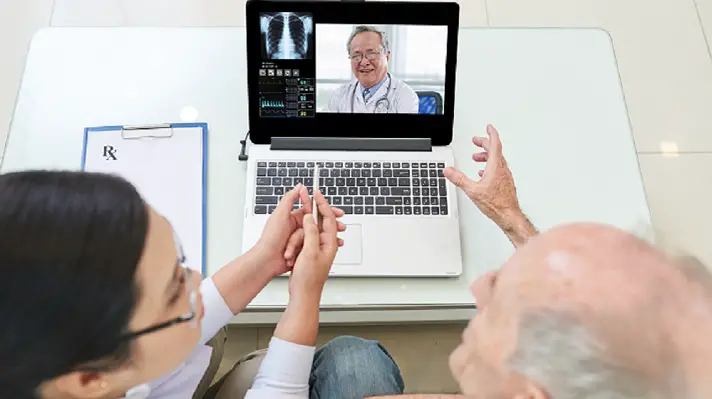

COVID-19 has had a tremendous impact on all of us, and it’s likely that many aspects of our daily lives will never return to “normal.” In the same way that we scoff at the notion of driving cars without seatbelts today, we’ll likely feel the same about many other previously normal things we did pre-pandemic.
This will most certainly include the way we manage high-risk spaces where there’s close contact and a higher than average risk of infection – like hospitals, airports, retail stores, restaurants, gyms, and more. These spaces could require the addition of constant monitoring using sensors and IoT devices to track people, temperatures, movements, and items. This would make it possible to monitor environmental health risks in real-time.
This approach may sound extreme at first, but in places such as hospitals, it becomes crucial, because these spaces host vulnerable populations, infected individuals, as well as healthcare workers. The importance of keeping healthcare workers healthy has never been more top of mind. With shortages of masks, gloves, and other protective equipment, as well as international efforts to “flatten the curve,” we now recognize a critical weakness in the healthcare system as it has been forced to scale in the face of the COVID-19 global pandemic.
Healthcare workers are the most likely to be infected with COVID-19 within a healthcare facility. Between February 12 and April 9, among 315,531 COVID-19 cases reported to the CDC, 9,282 or (19%) were identified as healthcare professionals. Additionally, 20% of positive tests in Ohio, have been healthcare workers. This can be especially dangerous because symptoms may not appear for up to two weeks, meaning healthcare workers can transmit the virus to non-COVID-19 patients who have pre-existing health conditions.
Aside from maintaining a plentiful inventory of protective equipment such as masks and gloves, technological advancements can create “smart” hospitals with the ability to sense, analyze, and enable real-time human-machine collaboration to take immediate action on events. “Smart” hospitals provide a proactive and accurate way to maintain cleanliness standards, adhere to sanitation protocols, and monitor patients, employees, and assets to keep everyone safe.
Stopping the spread
While COVID-19 patients in hospitals are often secluded to private rooms, they may need to be brought to other areas for imaging or other services, potentially contaminating other areas. COVID-19 spreads primarily from person to person through small droplets from the nose or mouth, which are expelled when the person coughs, sneezes, or speaks. These droplets can be inhaled by healthy individuals, but they can also land on objects and surfaces such as doorknobs and handrails, and it’s possible to become infected by touching these surfaces and then touching one’s eyes, nose, or mouth.
We know that in hospitals it’s crucial to ensure that there is an established plan to keep infected individuals from having unnecessary contact with non-infected individuals. It’s also important that there’s thorough cleaning and disinfecting of spaces, facilities, or machines for patients with non-COVID-19 care needs.
Contact tracing becomes extra important when an infection is present, but in practice can be challenging. Typically, staff must work with the patient to help them recall everyone they’ve had close contact with during the time they may have been infectious. This can be difficult and is easy for patients to forget encounters, particularly as they come down with the infection.
To improve this process in high-risk areas like hospitals, an electronic real-time tracking system can be used using sensors and cameras throughout a hospital to keep track of who and what each person comes into contact with. This could be other patients, equipment, or simply the areas they have spent time throughout the facility to help reduce the risk of contamination and infection spread.
Further, the system could also be configured so that when a patient comes in contact with a piece of equipment, an alert such as a text message or email can be triggered to ensure that the equipment is cleaned. This can also be performed retroactively if the patient is only known to be infected after the fact.
Sanitation and physical distancing
Sanitation and physical distancing have been a cornerstone of successful virus containment within our communities. So naturally this responsibility must be extended to healthcare facilities to protect both healthcare workers and our most vulnerable. Hospitals can measure the effectiveness of protocols and identify areas of the facility that require additional security or increased signage.
IoT devices such as bio-stickers can be used to capture a patient’s temperature or other vitals to be streamed to the care teams’ laptops, tablets, or mobile devices. This reduces the need for staff to come in physical contact with infected patients.
Tracking physical distancing and facial covering requirements can be done using cameras, whereas hand sanitization compliance can be tracked by relating staff sensor locations to IoT-enabled dispensers. Based on individual hospital policies and CDC recommended guidelines, when a staff member comes within proximity of a hand sanitizer dispenser in key areas requiring sanitation, sensors within the dispenser can trigger an alert to be sent to the employee’s device reminding them to sanitize their hands. Sinks and handwashing stations however would require video or other visual tracking to verify compliance.
This global COVID-19 pandemic has opened our eyes to ways we need to better support our hospitals and the essential frontline workers risking their lives to keep us healthy and safe. As technology and digital solutions are part of our everyday lives, they are also here to help ease the burden on our healthcare system and build smarter, more connected hospitals that will ultimately benefit all of us, every day.
About Scott Heather, Vice President of Professional Services US, Bits In Glass
As Bits In Glass’ Vice President of Professional Services in the US and Practice Lead for Blue Prism and VANTIQ, Scott is responsible for the overall performance and execution of these lines of business, as well as the strategy for implementation and customer success. He has over 19 years of Information Technology experience with a focus on deploying business process solutions on a variety of enterprise software platforms.
